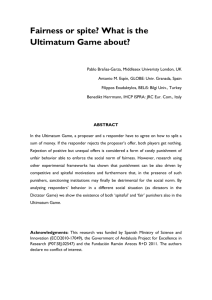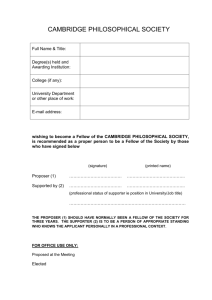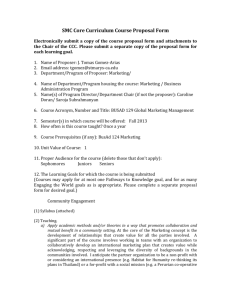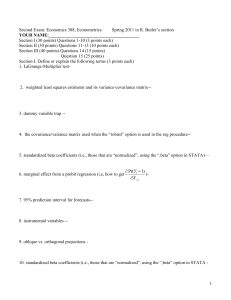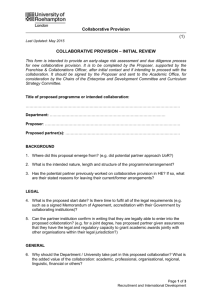Theory of Mind Enhances Preference for Fairness
advertisement
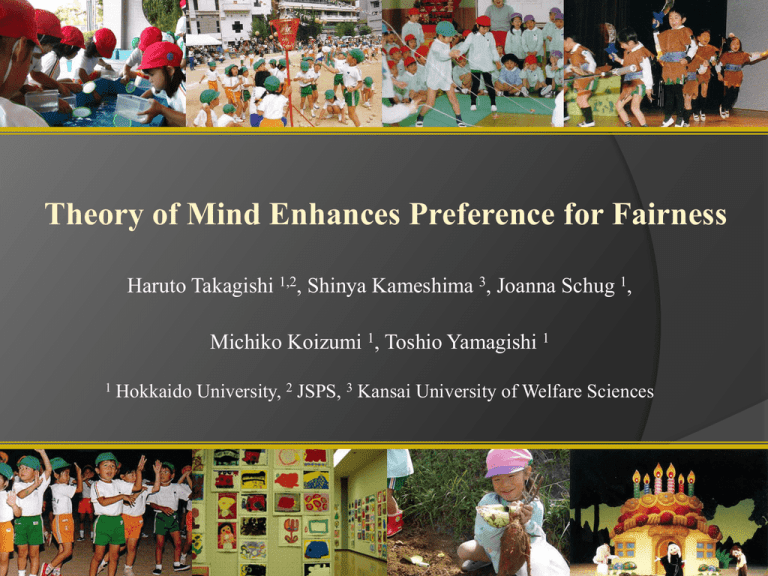
Theory of Mind Enhances Preference for Fairness Haruto Takagishi 1,2, Shinya Kameshima 3, Joanna Schug 1, Michiko Koizumi 1, Toshio Yamagishi 1 1 Hokkaido University, 2 JSPS, 3 Kansai University of Welfare Sciences Cooperation and Punishment Punishment of norm violators promotes cooperative behavior (Yamagishi, 1986; Fehr & Gatcher, 2002) Cooperation and Punishment Punishment of norm violators promotes cooperative behavior (Yamagishi, 1986; Fehr & Gatcher, 2002) Threat of peer punishment enhances proposer’s offers to the responder in the ultimatum game (Spitzer et al., 2007) Anticipating that others may become angered by and punish those who behave unfairly encourages us to follow social norms Cooperation and Punishment Punishment of norm violators promotes cooperative behavior (Yamagishi, 1986; Fehr & Gatcher, 2002) Threat of peer punishment enhances proposer’s offers to the responder in the ultimatum game (Spitzer et al., 2007) Anticipating that others may become angered by and punish those who behave unfairly encourages us to follow social norms We examine the effect of the ability to anticipate others’ social preferences on fairness-related behavior. Developmental studies of Fairness Developmental study of economic decision-making has received considerable attention in recent years Developmental studies of Fairness Developmental study of economic decision-making has received considerable attention in recent years A developmental study investigating fairness in children and adolescents ranging from seven to eighteen years of age found that the preference for fairness increases with age (Harbaugh et al., 2003) Developmental studies of Fairness Developmental study of economic decision-making has received considerable attention in recent years A developmental study investigating fairness in children and adolescents ranging from seven to eighteen years of age found that the preference for fairness increases with age (Harbaugh et al., 2003) Fairness-related behavior toward in-group members, increases with age among children age three to eight (Fehr et al., 2008) Developmental studies of Fairness Developmental study of economic decision-making has received considerable attention in recent years A developmental study investigating fairness in children and adolescents ranging from seven to eighteen years of age found that the preference for fairness increases with age (Harbaugh et al., 2003) Fairness-related behavior toward in-group members, increases with age among children age three to eight (Fehr et al., 2008) And many other studies have been conducted (Sally & Hill, 2005; Benenson, Pascoe, & Radmore, 2007; Gummerum, Keller, Takezawa, & Mata, 2008; Olson, & Spelke, 2008) Theory of Mind and Economic Decision-making Autistic Spectrum Disorder (ASD) had a substantial negative effect on the amount of tokens allocated by the proposer in the ultimatum game (Sally, & Hill, 2005) Theory of Mind and Economic Decision-making Autistic Spectrum Disorder (ASD) had a substantial negative effect on the amount of tokens allocated by the proposer in the ultimatum game (Sally, & Hill, 2005) Chimpanzees, who do not have a well developed theory of mind in the human sense made unfair offers and accepted unfair offers in the ultimatum game (Jensen, Call, & Tomasello, 2007) Theory of Mind and Economic Decision-making Autistic Spectrum Disorder (ASD) had a substantial negative effect on the amount of tokens allocated by the proposer in the ultimatum game (Sally, & Hill, 2005) Chimpanzees, who do not have a well developed theory of mind in the human sense made unfair offers and accepted unfair offers in the ultimatum game (Jensen, Call, & Tomasello, 2007) However, to date no study has directly investigated the role that theory of mind plays in fairness-related behavior among normally developed children Hypothesis In this study, we examined the role of theory of mind in the proposer’s behavior in the ultimatum game We predicted that compared with proposers who had not yet developed theory of mind, proposers who had developed theory of mind would behave in a more fair manner Methods (participants) Sixty-eight preschoolers (36 males and 32 females) participated in the study The mean age in month was 65.76 (SD = 7.0) Fifty-six from an older class (6 years) and twelve from a younger class (4 years) All participants played the ultimatum game and the false belief task Methods (The Ultimatum Game) The participants played a one-shot ultimatum game The proposer received 10 candies from the experimenter and decided how to divide the amount of candies between two players (the propose and the responder) Then, the responder accepted or rejected the proposer’s offer If the responder accepted the offer, then both received the amount of candies according to the proposer’s offer If the responder rejected the offer, then both received nothing Methods (The Ultimatum Game) PROPOSER tray candies lever RESPONDER PROPOSER candies candies RESPONDER black box candies candies lever Methods (False Belief Task) Acquisition of theory of mind was determined by whether or not participants successfully completed a false-beliefs task (Sally-Anne task; Baron-Cohen et al., 1985). Methods (False Belief Task) bag A girl stores a ball in a box and leaves the room. box Methods (False Belief Task) bag The boy moves the ball to a bag Methods (False Belief Task) ? When the girl returns, the participant is asked where the girl will look for the ball. Results (Amount offered by the proposer) 67.7 % of the proposers and 73.5 % of the responders passed the false-beliefs task Results (Amount offered by the proposer) 67.7 % of the proposers and 73.5 % of the responders passed the false-beliefs task *The mean offer to the responder 8 7 6 t (32) = 2.36, p < .05 5 4 3 2 1 0 passed (n = 23) failed (n = 11) *Distribution of proposer’s offers Results (Multiple Regression Analysis) Table 1 Regression Analysis of the Amount Offered to the Responders Independent Variables β Sex Dummy (Male = 0, Female = 1) .24 Relationship Quality .13 Age in month Theory of Mind Dummy (Failed = 0, Passed = 1) R2 * p < .05 - .03 .39 * .22 The participants’ teachers evaluated the quality of the relationship between all 34 pairs (1= very bad relationship to 7= very good relationship) Results (Multiple Regression Analysis) Table 1 Regression Analysis of the Amount Offered to the Responders Independent Variables β Sex Dummy (Male = 0, Female = 1) .24 Relationship Quality .13 Age in month Theory of Mind Dummy (Failed = 0, Passed = 1) R2 * p < .05 - .03 .39 * .22 The participants’ teachers evaluated the quality of the relationship between all 34 pairs (1= very bad relationship to 7= very good relationship) Results (Multiple Regression Analysis) Table 1 Regression Analysis of the Amount Offered to the Responders Independent Variables β Sex Dummy (Male = 0, Female = 1) .24 Relationship Quality .13 Age in month Theory of Mind Dummy (Failed = 0, Passed = 1) R2 * p < .05 - .03 .39 * .22 The participants’ teachers evaluated the quality of the relationship between all 34 pairs (1= very bad relationship to 7= very good relationship) Results (Multiple Regression Analysis) Table 1 Regression Analysis of the Amount Offered to the Responders Independent Variables β Sex Dummy (Male = 0, Female = 1) .24 Relationship Quality .13 Age in month Theory of Mind Dummy (Failed = 0, Passed = 1) R2 * p < .05 - .03 .39 * .22 The participants’ teachers evaluated the quality of the relationship between all 34 pairs (1= very bad relationship to 7= very good relationship) Results (Multiple Regression Analysis) Table 1 Regression Analysis of the Amount Offered to the Responders Independent Variables β Sex Dummy (Male = 0, Female = 1) .24 Relationship Quality .13 Age in month Theory of Mind Dummy (Failed = 0, Passed = 1) R2 * p < .05 - .03 .39 * .22 The participants’ teachers evaluated the quality of the relationship between all 34 pairs (1= very bad relationship to 7= very good relationship) Results (Rejection Rates) 63.6% of unfair offer were rejected by the responders, while all 23 fair or hyper fair offers were accepted *Rejection rates of unfair offer 100 80 % ns. 60 40 20 0 passed (n = 7) failed (n = 4) Results (Rejection Rates) 63.6% of unfair offer were rejected by the responders, while all 23 fair or hyper fair offers were accepted * Rejection rates of each offer Summary & Discussion Our results showed that theory of mind had a major effect on fairness-related behavior of the proposer Preschoolers who acquired theory of mind proposed a fairer division of the candies Summary & Discussion Our results showed that theory of mind had a major effect on fairness-related behavior of the proposer Preschoolers who acquired theory of mind proposed a fairer division of the candies Our study also showed that theory of mind do not affect rejection behavior The unfair outcome itself (e.g., inequity aversion; Fehr & Schmidt, 1999) may play a more important role in rejection behavior among preschoolers than among adults Thank you for your attention !! The Ultimatum Game Machine. Appendix 1: The Effect of Age Table 1 Regression Analysis of the Amount Offered to the Responders Independent Variables Model 1 Model 2 Model 3 β β β Sex Dummy (Male = 0, Female = 1) .17 .14 .24 Relationship Quality .21 .21 .13 .10 - .03 Age Theory of Mind Dummy (Failed = 0, Passed = 1) R2 * p < .05 Fifty-six from an older class (6 years) and twelve from a younger class (4 years). .39 * .08 .09 .22 Appendix 2: Relationship Quality The post experimental questionnaire The participants’ teachers evaluated the quality of the relationship between all 34 pairs (1= very bad relationship to 7= very good relationship) Appendix 2: Emotion ? Belief ? We conducted the second experiment. Ultimatum Game + False belief Task + Emotion Understanding Task (Denham, 1986) Patticipants (N = 146) Forty eight 6 years old children Fifty two 5 years old children Forty six 4 years old children Table 1 Regression Analysis of the Amount Offered to the Responders Independent Variables Sex Dummy (Female = 0, Male = 1) Class (younger = 0, middle = 1, older = 2) Model 1 Model 2 Model 3 -0.14 -0.16 - 0.10 0.36** Affective perspective-taking 0.38** 0.24 0.02 0.02 Theory of Mind Dummy (Failed = 0, Passed = 1) R2 * p < .05, ** p < .01 0.27* 0.15 0.18 0.23
